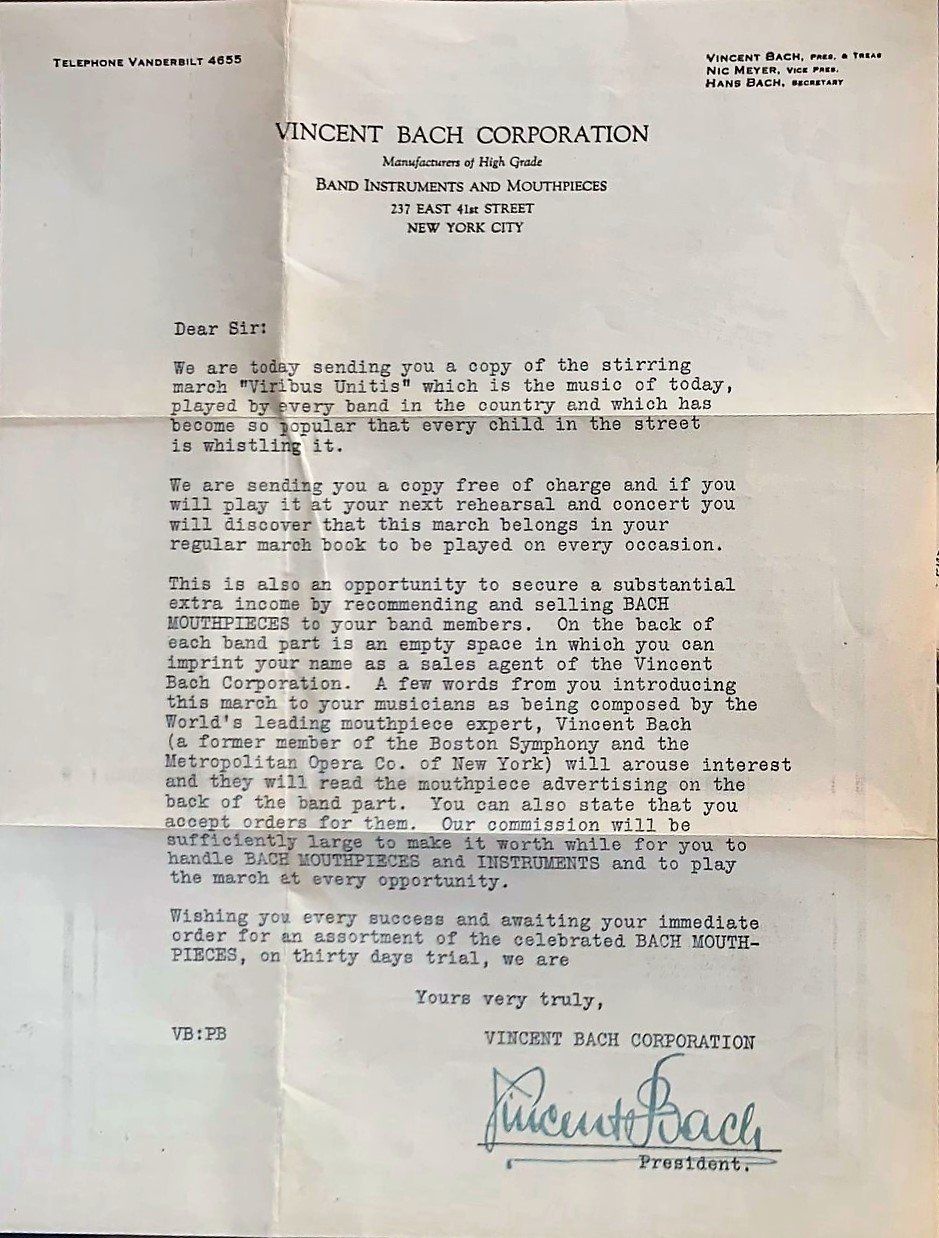Bach Trumpet 959 with Original Finish
When this trumpet was completed on February 2, 1928, Vincent Bach had been making trumpets for just over 3 years, but assuming that he was using all the serial numbers in sequence, had increased production to over 300 a year. This seems too large a production for such a young company, but some parts were most likely being made by a larger maker, possibly the valve sections.
His trumpets were expensive but he had gained an excellent reputation in earlier years as a cornet and trumpet soloist and then making mouthpieces. Judging by examples of early Bach trumpets that have gone through my shop, they were superior in playing characteristics from the very start. In the years that I have owned this trumpet many excellent players have wanted to try it out and none, so far, have told me that it is less than an excellent instrument. Fortunately it is very well preserved and not suffered misguided modifications as so many other old Bach trumpets have. The previous owner was Doc Severinsen, who did try several other mouthpipes on it but had the sense to keep the original.
Click on an image below for larger views.
The original shop card indicates "Engr fin 5 gold". Finish 5 meant that it was burnished (polished as apposed to satin) and gold plated. I've worked on at least 10 other early engraved Bach trumpets and it is obvious that he used several different engravers. The engraving on this one is as high quality as I've seen on a Bach. Aside from the cartouche surrounding the stamped lettering, it is all straight cut rather than the more typical wiggle cut engraving which takes much less skill. A plain brass Bach trumpet was already expensive in 1928 at $125 compared with a Conn 2B, a similarly deluxe model, for $90. Burnished gold plating with this engraving cost $200, with only one more expensive option being engraving inside the bell additionally for $210. This trumpet has a model 6 bell and mouthpipe with a bore measuring .462". It is 18 7/8" long with bell rim diameter of 4 3/4".
Update, February, 2011:
I've just learned more of the history of this Bach trumpet, including information making it more important to the history of the company than I had known. Bill Meyer, the grandson of "Nic Meyer", the original owner that is indicated on the shop card, stumbled across this page, recognized the instrument and contacted me by email. His father George, then wrote me an email with all the information that he could remember. George's father Nicholas Meyer (Oct. 21, 1897 to Jan. 8, 1979) had been running a grocery store with his mother after his father had died. He still found time to play trumpet in theater orchestras in Manhatten in the 1920s and this is where he met Vincent Bach. Bach had been making mouthpieces for years and had already made a few trumpets, so I would assume that this was 1925. Bach wanted to increase the size of his trumpet production, but needed capital to do so. In order to accomplish this he sold Nicholas and his mother shares in the company (company records indicate that this was more likely a personal loan). Nic acquired this trumpet a few years later.
The Vincent Bach Corporation letterhead illustrated below indicates that Nic Meyer was vice president at the time. This undated letter mentions the sales of trumpets and was likely written between 1925 and 1928. This image was graciously provided by Todd Hoff of The Bach Loyalist.
George Meyer's older brother Walter briefly worked for Bach in the early 1940s as a bell maker, leaving to join the military when we went to war. Wartime production enabled Bach to purchase back the Meyer's shares in his company, a deal which included all expenses for George to attend Ernest Williams music camp and a new Bach cornet for him to play.
After school, George spent three years in the US Navy Band. In 1977, George had John (Peppy) Pettinato, former Bach employee that was well known to brass players for high quality repairs, do some repairs to this trumpet including removing some dents, cleaning and polishing. Years later, he sold it to Doc Severinsen while raising funds to pay for Bill's college education.
Doc had no intension to sell this trumpet, but he had previously traded to me a Besson trumpet that had belonged to Reynold Schilke for another 1930s Besson trumpet that he thought played better. I didn’t want to sell Schilke’s Besson trumpet, being a historically important example. I told him that he could only get it in exchange for his Bach #959, which I had worked on about a decade before and still had fixed in my memory.







